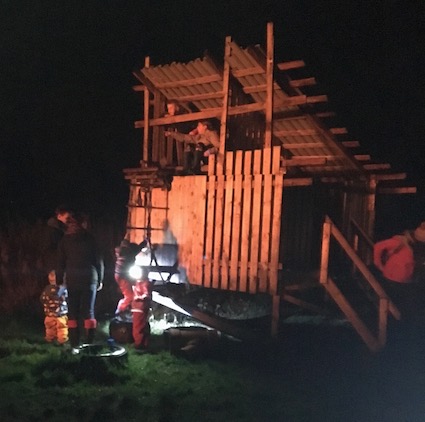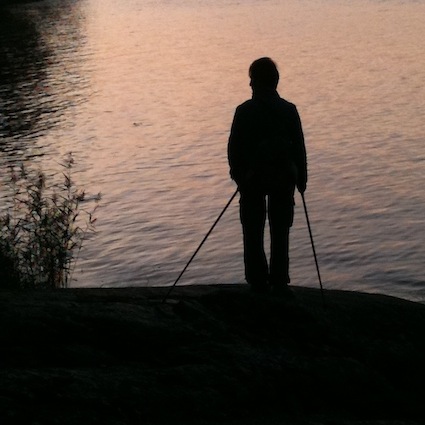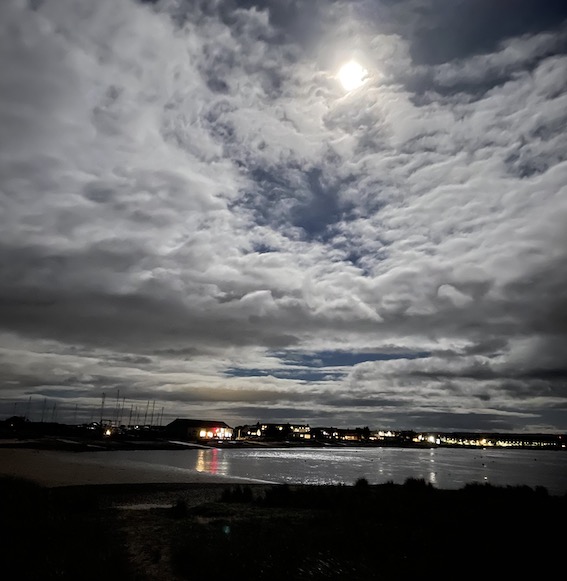During winter months, many children who attend early learning and childcare settings are likely to be outdoors in the dark. This offers many exciting opportunities for storytelling, games and exploring the environment in different conditions. When I worked in an outdoor residential centre, each member of staff took it in turns to lead the night time activities. This allowed the visiting classes to get to know the site in a different way.
Becoming confident in the dark at a young age should mitigate children developing a fear of the dark. Although Scotland has short days in the winter, especially further north, there are many ways to ensure your site is light enough for comfort and safety yet instils a sense of magic and adventure.
Playing outside in the dark helps children use all their senses and learn:
- How animals and plants behave in the night time
- How to “be” outside in the dark – what to wear, how to look after oneself, how to seek help if needed
- About the different seasons and changes such as the days getting shorter
- That the dark is not always truly dark – different shades of darkness exist
1. Bringing additional light into an outdoor space
Useful approaches to consider regarding bringing additional light into the space include:
- The use of carefully placed solar lights and lamps, e.g. along paths and around identified hazards
- Who carries or wears torches: why and how to make this unobtrusive
- The use of movement sensor lights which automatically switch on when someone is nearby but switch off automatically when no movement is detected
- Fairy lights that make the outdoor space feel special and unique at night. These can be added to shelters, indoor spaces and other features depending whether they are designed for indoor or outdoor use
- The decoration of trees with lights as an ongoing rather than Christmas option
- Looking for opportunities to celebrate Diwali, Hannukah and other festivals of light at appropriate times of the year
- The use of lights which children want to attach to themselves. For example flashing lights around the ankles are often less obtrusive than a head torch that shines into people’s faces
- Making the most of moonlight on clear early evenings.
- The use of candle lanterns, depending on the age and maturity of your group, the terrain, weather and nature of your planned activities.

2. Addressing fears and concerns
Consider how to help children and staff feel safe, nurtured and supported as they manage any perceived risks.
- Encourage children to think of fading light, dusk and darkness as routines within the day which offer different experiences.
- Reading aloud the book The Owl Who Was Afraid of the Dark by Jill Tomlinson can be a useful entry point for P1 or P2 classes. The link takes you to East Ayrshire’s Outdoor Education activities.
- Be aware of any child or staff who have a visual impairment that is affected by the dark and put in place measures to support.
- Some children may need to build up their confidence and strategies should be discussed with themselves, possibly their parents and written into their personal plan. It can be helpful to find out if anything is underpinning any worries or fears.
3. Practical safety tips
The following is merely food for thought and should not be taken as definitive guidance
- Know the area really well where you are playing.
- Undertake a risk benefit assessment: the hazards and risks and different in the dark where there is significantly less visibility. Consider people, place and play or learning possibilities.
- Any activities involving fire or naked flames may need a separate risk benefit assessment.
- What clothing do children and adults need to wear to stay warm and as safe as necessary?
- Think about light. Often a candle or torch draws our eyes towards this light source and can make the dark seem even darker. Be mindful of the impact of flashing torches directly onto people’s faces.
- How will the sessions be supervised? Think carefully about the numbers of adults needed and the level of support the children require at an individual and group level. You may decide to focus on the use of a specific space within your outdoor space, if you don’t have the staffing levels you need.

4. Watch the sunset
The best way to learn about the stars is to watch them appear on a clear night just after the sun sets. Get a comfy insulation mat, snuggle into a sleeping back, lie down on your back and watch the show! Look out for man-made flying objects and UFOs too. There are lots of astronomy apps which can be used to assist you in identifying the constellations.There are also many stories and legends from different cultures that are used to explain the layout of constellations which can also help children remember.
As the sun goes down, it can also be a perfect time to explore silhouettes and enjoy the outlines of different landscape features such as trees and other plants structures. Or why not play about and take photos creating the perfect pose 🙂
5. Moonlight shadows
On a bright clear winter’s night when there is a full moon or thereabouts, go for a walk in a park or other place where you can look at the shadows made by the moon. In what way do they differ from sun shadows? It can also be interesting looking at the lights in towns and viewpoints where a town can be seen all lit up.

6. Adjust your eyes
It’s easy to go glitzy and bring on the light festivals when it’s dark. Arguably, we miss more action than we see when torches, fires, lights and lanterns are present. They stop our eyes from adjusting to the dark. Go for a light free walk in a natural space where there are no street lights and see the world of darkness. Is it as dark as you thought? It is a good idea to choose a path which everyone has walked beforehand in day time so the route is familiar.
7. Dark sky festivals
One of the most enjoyable community activities look out for a Dark Sky Festival near you, to learn about the night sky. This is useful for meeting astronomers and those who can help explain the different star formations and what’s happening in the night sky. Let your families know about local events.
8. Nocturnal minibeasts
Use a torch and Investigate tree stumps, log piles and other places where minibeasts congregate. Look underneath stones and logs. There may be lots of minibeast activity happening. Who are the night time party animals? Look and see what happens when a light is shined on these places. Often it is the scurrying of minibeasts which gives a clue to their existence. Do an experiment to find out whether minibeasts prefer light or dark places to live. Design a fair test.
In consultation with a naturalist or wildlife professional, it is also possible to set up humane moth traps or similar to find out what species live nearby.
9. Be a nocturnal animal
Find out about animals which are nocturnal. Look for evidence of nocturnal animals, e.g. foxes, badgers, owls, bats, etc. Remind people to wear quiet clothes which do not rustle and footwear which doesn’t clomp. Is it possible to move silently along at night? How does this feel? Games such as one person being “it” and sitting in the centre of a large circle with a torch. The rest of the group slowly advance without making a sound. If the “it” person hears a sound they flash the torch in the direction it comes from. It is is a person who made the noise, they must sit down. The aim is for the group to work together so that everyone moves to the “it” person and no-one is out.
10. Become invisible
Is it true that if you close your eyes you become invisible? Does it depend upon whether it’s night or day? Experiment with a friend. Does the dark dim people’s outlines?
11. Shiny, happy people
Experiment with reflective material, freebie wrist bands and dangly reflectors. Is it better to be dripping with reflectors or to just wear reflective material and items in one or two places on your body? What works best? Check out the Think! Road Safety Resources.
12. Light trails
Along a path or in your outdoor space, hide reflective bands and discs. Let your friends see if they can find the exact amount by searching for them with torches.
13. Light lanterns
Create little lanterns from glass jars or willow withies and paper. Decide where is the best place to hang them outside. What are the pros and cons of using torches versus tea lights? The light source will affect the type of lantern which can be made. Snow lanterns are a lot of fun too. Do an online search for some wonderful images.
14. Shadow puppets
Create a shadow puppet theatre in the dark. What materials will you need? Where is the best place to position a torch? What material creates the best effect? It can be a lot of fun, if our bodies are the puppets.
15. Learn morse code and emergency signals
Using a torch can be a good motivation to learn morse code. What emergency signals also use flashing lights? Can we learn the patterns needed to seek help if needed?
16. Limbo in the dark
Rather than moving under a stick without touching it, this game involves creating a beam of light from a torch. The light beam should not be broken as children take turn to bend or crawl underneath it.
17. Glow in the dark collections
Build up a collection of glow-in-the-dark toys such as flying disks, balls and stars. These can be great for using – often families may have resources and toys they no longer need and can donate to your collection.
18. Have a night time campfire
If your group is used to gathering around a campfire, it can look and feel quite different at night. It can be a place for telling stories, staring into the fire and enjoying warm drinks.
19. Adapt traditional and well-known games
Many games that are played during the daylight hours can be easily adapted to the hours of darkness especially for older children. These can include sardines, hide ‘n’ seek and so on.
20. Develop a community dark festival tradition
Stramash Fort William now welcome back old and new children and their families with an annual bonfire and fireworks event. It’s been running for many years and a wonderful way of everyone having a good catch up.
This post was originally published in November 2013.




















Lots of lovely ideas, I’m sure little man would like most of them, especially making himself shiny! #countrykids x
Thanks Lilinha – you are right – most children do like making themselves very shiny!
Some wonderful ideas there for night time play. Perfect at this time of the year too. We have just been having our Halloween celebrations which ran into lots of nighttime fun. Thank you for sharing some great ideas on Country Kids
Yes – your Halloween photos were great. For anyone who wants a look, see the post here: http://www.coombemill.com/blog/post/2013/11/04/Coombe-Mill-Farm-does-Halloween.aspx
Always great ideas. great earth science ideas. would love to share on google+ but dont see a button!
fyi.
Thanks for your feedback. The G+ button is below every post along with Twitter, Facebook, LinkedIn, Reddit, Stumble Upon, etc.
The three big buttons at the top LH column just go to my FB, Twitter and Pinterest pages.
What I really miss is the Joliprint pdf button – sadly the company that did this folded earlier this year and it was so handy.
I never thought about all these ways to play in the dark! Since it’s getting dark so early now these will come in handy!